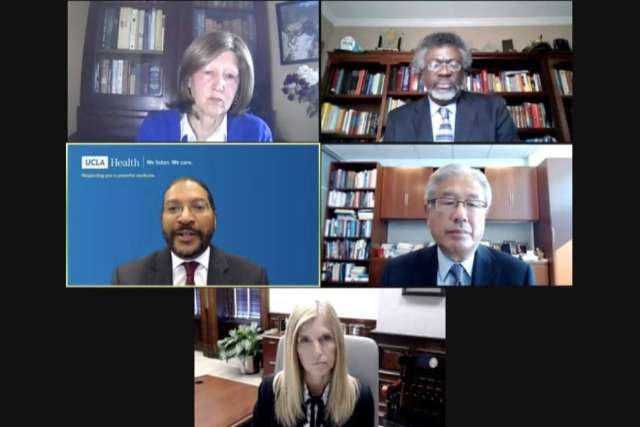Health care workers already were feeling burned out — then came the COVID-19 pandemic, intensifying their workloads and exacerbating their stress levels.
Complex and converging factors — from society’s eroding trust in science to increasing health care costs and a disjointed health care system — contribute to growing feelings of isolation, loneliness and burnout among doctors, nurses and other frontline workers, says Robert Cherry, MD, MS, chief medical and quality officer for UCLA Health.
Dr. Cherry was among the speakers at a U.S. News & World Report webinar, Nov. 9, on the topic of “Restoring a Burned-Out Healthcare Workforce.” Also on the panel were Victor Dzau, MD, president of the National Academy of Medicine; Ernest Grant, PhD, RN, president of the American Nurses Association; and Redonda Miller, MD, MBA, president of The Johns Hopkins Hospital.
“This is a topic that we all need to get on top of and address because it’s a crisis,” said Dr. Dzau. “Before COVID, we already knew that physicians have twice the risk of burnout as the general population, and the rates of depression and suicidal ideation are alarmingly high, at around 40%. And it’s not unique to physicians – nurses and other frontline workers also experience the same challenges.”
In a Los Angeles Times op-ed earlier this year, Dr. Dzau suggested the need for a national strategy to help health care workers recover from the stress of the pandemic.
A nationwide nursing shortage is only further increasing health care workloads. The American Medical Association and the U.S. Bureau of Labor Statistics predict a need for 1.2 million additional nurses in 2022 to meet health care demands, said Dr. Grant, who has asked U.S. Secretary of Health and Human Services Xavier Becerra to declare the nursing shortage “a national crisis.”
“This is not something we can solve on our own,” Dr. Grant said.
Health care workers of all kinds have left the field in recent years because of burnout, Dr. Cherry added, leading to staffing shortages throughout the system.
So what can be done?
Potential solutions are multifaceted, the panelists said, comprising education and recruitment, individual institutional approaches and national strategies.
Some strategies for alleviating and preventing burnout suggested by the panelists include:
Proactively address frontline workers’ health needs: “I think that well-being for all of the members of the health care team should be part of a facility's strategic plan,” Dr. Grant suggested. “It shouldn't be a reactive response.”
He encouraged the use of free programs, such as Healthy Nurse Healthy Nation, that support health care workers in caring for their own health through activity, nutrition, rest and recreation.
Foster a supportive work environment: Dr. Dzau echoed this preventive approach, suggesting organizations establish Chief Wellness Officers whose job is to monitor and support staff well-being.
He also cited stigma as an issue. “People are afraid to speak up and recognize they have this burnout, because they worry what would it mean to their licensure and to their reputation,” he said. “We need to give people a safe environment.”
Listen to workers’ needs and involve them in finding solutions: “It is so critical that staff, both clinical and non-clinical, have their voices heard,” said Dr. Cherry. “The key is really understanding what their local problems are and helping them to support them through solutions, because they know best how to actually optimize those operational workflows that are a challenge day by day.”
Dr. Miller said some of the most useful solutions to pandemic-specific challenges at Johns Hopkins came directly from frontline workers.
Pursue systemic change that prioritizes health care workers’ well-being: It’s not just about finding solutions that work for individual hospital staffs, but creating a systemwide culture that supports worker well-being, Dr. Dzau said. That means rethinking hierarchical structures, harassment policies, data management and more.
“I do believe that we need to put the wellness issue highest on the agenda, because without wellness of your staff, you’re not going to achieve your mission,” he said. “That requires national, global work to change this.”



